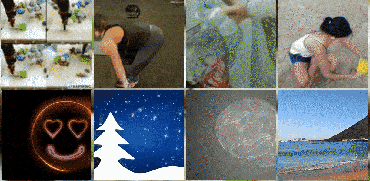Video Prediction
183 papers with code • 19 benchmarks • 24 datasets
Video Prediction is the task of predicting future frames given past video frames.
Gif credit: MAGVIT
Source: Photo-Realistic Video Prediction on Natural Videos of Largely Changing Frames
Libraries
Use these libraries to find Video Prediction models and implementationsDatasets
Latest papers with no code
State-space Decomposition Model for Video Prediction Considering Long-term Motion Trend
In this paper, we propose a state-space decomposition stochastic video prediction model that decomposes the overall video frame generation into deterministic appearance prediction and stochastic motion prediction.
Predicting Long-horizon Futures by Conditioning on Geometry and Time
To address both challenges, our key insight is to leverage the large-scale pretraining of image diffusion models which can handle multi-modality.
TAFormer: A Unified Target-Aware Transformer for Video and Motion Joint Prediction in Aerial Scenes
To address this issue, we introduce a novel task called Target-Aware Aerial Video Prediction, aiming to simultaneously predict future scenes and motion states of the target.
Probabilistic Forecasting with Stochastic Interpolants and Föllmer Processes
We propose a framework for probabilistic forecasting of dynamical systems based on generative modeling.
CarbonNet: How Computer Vision Plays a Role in Climate Change? Application: Learning Geomechanics from Subsurface Geometry of CCS to Mitigate Global Warming
We introduce a new approach using computer vision to predict the land surface displacement from subsurface geometry images for Carbon Capture and Sequestration (CCS).
Rolling Diffusion Models
Diffusion models have recently been increasingly applied to temporal data such as video, fluid mechanics simulations, or climate data.
Predicting the Future with Simple World Models
Abstracting the dynamics of the environment with simple models can have several benefits.
A Survey on Video Prediction: From Deterministic to Generative Approaches
Video prediction, a fundamental task in computer vision, aims to enable models to generate sequences of future frames based on existing video content.
Adversarial Augmentation Training Makes Action Recognition Models More Robust to Realistic Video Distribution Shifts
More precisely, we created dataset splits of HMDB-51 or UCF-101 for training, and Kinetics-400 for testing, using the subset of the classes that are overlapping in both train and test datasets.
Key-point Guided Deformable Image Manipulation Using Diffusion Model
In this paper, we introduce a Key-point-guided Diffusion probabilistic Model (KDM) that gains precise control over images by manipulating the object's key-point.


















 MNIST
MNIST
 Cityscapes
Cityscapes
 KITTI
KITTI
 Kinetics
Kinetics
 Human3.6M
Human3.6M
 DAVIS
DAVIS
 DAVIS 2017
DAVIS 2017
 KTH
KTH
 Something-Something V2
Something-Something V2
 Vimeo90K
Vimeo90K
